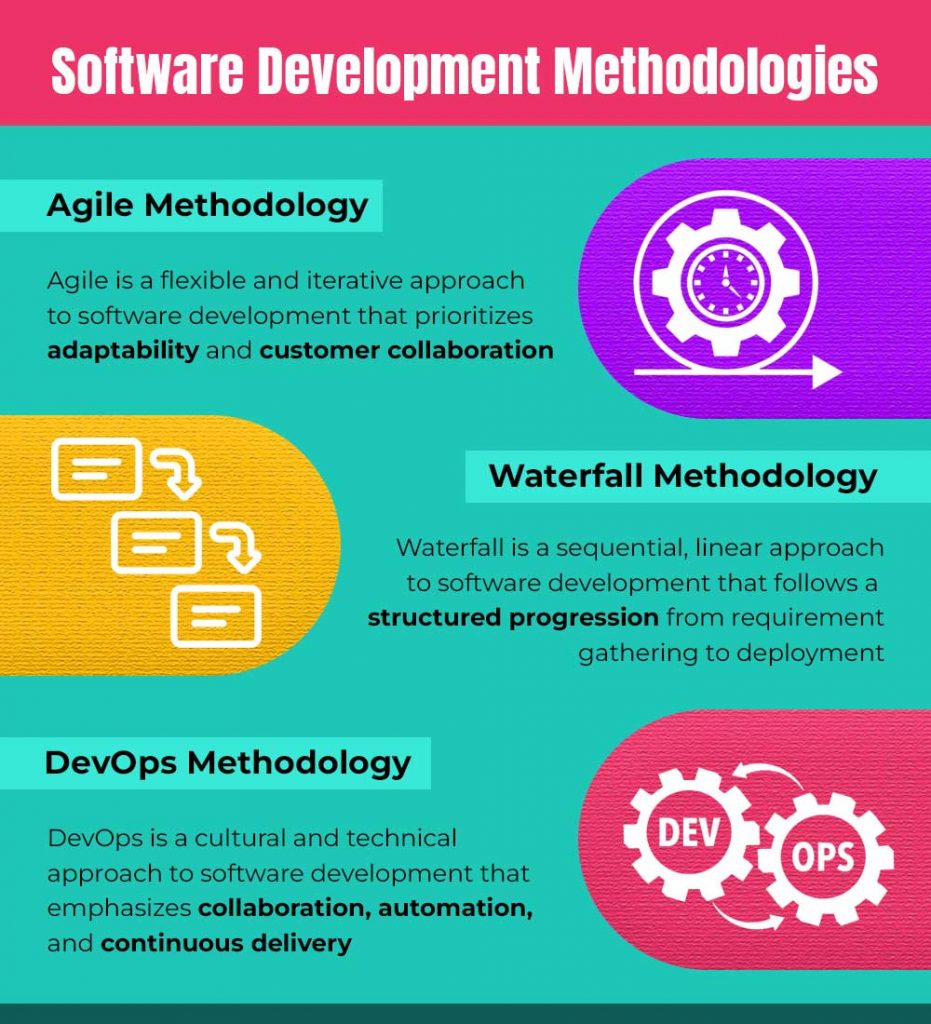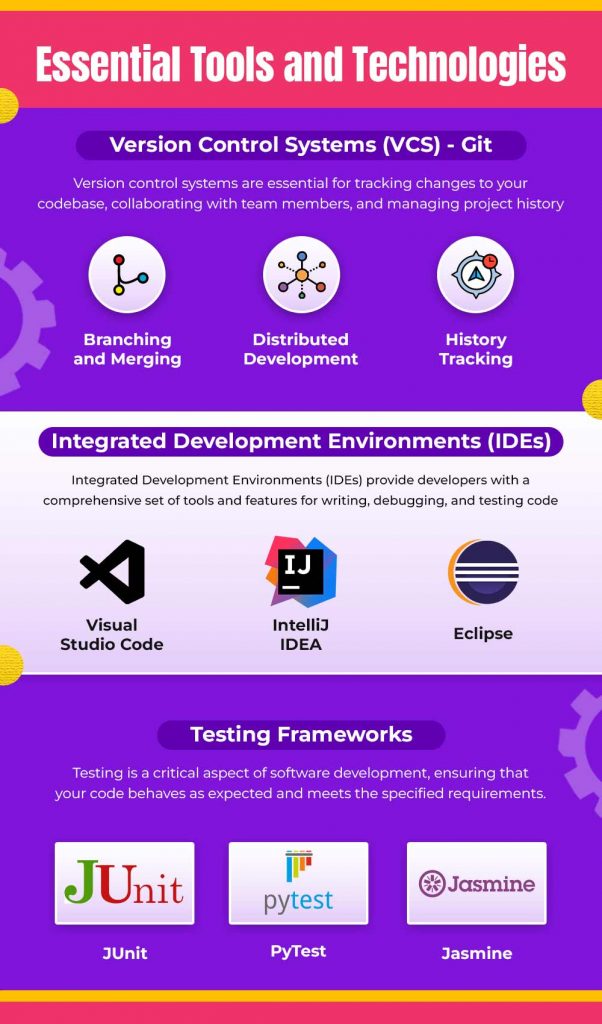Practical Guide To Master The Art Of Software Development
Are you intrigued by the digital realm, eager to create innovative applications, but feeling overwhelmed by where to start? Fear not! Welcome to the realm of software development, where creativity meets technology in crafting solutions that shape our digital world.
Software development is the art of crafting digital solutions through programming languages. From mobile apps to complex web platforms, every digital innovation stems from the expertise of software developers. But don’t let the term intimidate you; it’s essentially problem-solving with a keyboard!
Getting Started
1. Learn the Basics
Begin your journey by familiarizing yourself with fundamental concepts. Explore languages like Python, JavaScript, or Java, each with its unique strengths. Online platforms like Codecademy and Coursera offer interactive courses catering to beginners.
2. Dive into Resources
In the vast landscape of online learning, budding coders find themselves spoiled for choice. Platforms like Udemy, GeeksforGeeks, and w3schools stand out as beacons of knowledge, offering comprehensive courses in coding fundamentals. Supplementing this structured learning are the vibrant communities of Stack Overflow and YouTube, where solutions and tutorials abound. For those seeking a challenge, LeetCode and HackerRank present a playground of coding puzzles to hone skills and push boundaries. With this wealth of resources at your fingertips, the journey to code mastery is as exciting as it is rewarding.
3. Build, Break, Repeat
The essence of learning software development lies in hands-on experience. Start with simple projects, like building a personal website or a basic calculator app. Embrace failure as part of the process; debugging is where the real learning happens!
Understanding the Core
Software Development Methodologies
Software development methodologies are frameworks used by development teams to structure, plan, and control the process of creating software.
In the vast landscape of software development, choosing the right methodology can significantly impact the success of your project. From Agile’s flexibility to Waterfall’s structured approach and DevOps’ focus on collaboration, each methodology brings its own set of principles, benefits, and challenges.


Let’s break down each of them to help you make an informed decision for your next project.
Agile Methodology
Agile is a flexible and iterative approach to software development that prioritizes adaptability and customer collaboration. Here’s a detailed look at its key characteristics:
Principles:
- Iterative Development: Agile breaks down the development process into small, manageable iterations called sprints, typically lasting 1-4 weeks.
- Customer Collaboration: Continuous feedback from customers and stakeholders ensures that the product meets their evolving needs.
- Adaptability: Agile embraces change, allowing teams to respond quickly to new requirements or market conditions.
- Cross-Functional Teams: Collaborative teams comprising developers, testers, and business analysts work together to deliver high-quality software.
Pros:
- Flexibility: Agile allows for changes and iterations throughout the development process, making it suitable for projects with evolving requirements.
- Customer Satisfaction: Continuous feedback ensures that the final product meets customer expectations, leading to higher satisfaction.
- Transparency: Regular meetings and progress updates promote transparency and alignment among team members.
Cons:
- Requires Discipline: Agile demands active involvement and commitment from all team members, which can be challenging to maintain.
- Documentation Challenges: The emphasis on working software over comprehensive documentation may lead to gaps in documentation if not managed properly.
Waterfall Methodology
Waterfall is a sequential, linear approach to software development that follows a structured progression from requirement gathering to deployment. Here’s a closer look at its key characteristics:
Phases:
- Requirement Analysis: Gathering and documenting project requirements.
- Design: Creating a detailed system design based on the requirements.
- Implementation: Developing the software based on the design specifications.
- Testing: Verifying that the software meets the specified requirements.
- Deployment: Releasing the software to users.
Pros:
- Structure: Waterfall provides a clear and sequential approach, making it easy to understand and implement.
- Documentation: Detailed documentation at each stage ensures clarity and accountability.
- Predictability: The linear nature of Waterfall allows for better estimation of timelines and resources.
Cons:
- Limited Flexibility: Changes are difficult to incorporate once a stage is complete, potentially leading to delays and cost overruns.
- Client Involvement: Limited client interaction until the end of the project may result in misalignment with expectations.
DevOps Methodology
DevOps is a cultural and technical approach to software development that emphasizes collaboration, automation, and continuous delivery. Here’s a breakdown of its key principles:
Key Practices:
- Continuous Integration (CI): Automatically integrating code changes into a shared repository multiple times a day.
- Continuous Delivery (CD): Automatically deploying code changes to production or staging environments.
- Infrastructure as Code (IaC): Managing infrastructure through code to enable automated provisioning and configuration.
- Monitoring and Logging: Implementing tools for monitoring application performance and collecting logs for troubleshooting.
Pros:
- Collaboration: DevOps bridges the gap between development and operations teams, promoting seamless integration and communication.
- Continuous Delivery: Automation streamlines the delivery process, reducing time-to-market and enabling rapid iteration.
- Reliability: Focus on automation and monitoring ensures stable and resilient systems, minimizing downtime and outages.
Cons:
- Learning Curve: Implementing DevOps requires a cultural shift and investment in new tools and practices, which can be challenging for some organizations.
- Complexity: Managing the entire software lifecycle from development to deployment can be complex, especially for large-scale projects.
Choosing the Right Methodology
Selecting the appropriate methodology depends on various factors such as project size, complexity, team dynamics, and client requirements. Consider the following questions:
- Is the project scope well-defined, or are there potential changes in requirements?
- How important is client involvement and feedback throughout the development process?
- Are there specific compliance or regulatory constraints that need to be considered?
By evaluating these factors and understanding the strengths and limitations of each methodology, you can make an informed decision that aligns with your project goals and objectives.
In conclusion, there’s no one-size-fits-all approach to software development. Agile, Waterfall, and DevOps each offer unique advantages and challenges. By understanding their core principles and evaluating your project’s needs, you can choose the methodology that best suits your team and ensures project success.
Essential Tools and Technologies
Having the right tools and technologies can make all the difference in streamlining the development process and ensuring the quality of your software. In this section, we’ll explore some essential tools and technologies that every developer should be familiar with.


Version Control Systems (VCS) – Git
Version control systems are essential for tracking changes to your codebase, collaborating with team members, and managing project history. Git, in particular, has become the de facto standard for version control in the software development industry. Key features of Git include:
- Branching and Merging: Allows developers to work on different features or fixes simultaneously without interfering with each other’s code. Merging branches enables the integration of changes back into the main codebase.
- Distributed Development: Git’s distributed architecture allows developers to work offline and collaborate seamlessly, even across different time zones and geographical locations.
- History Tracking: Git maintains a complete history of changes to the codebase, making it easy to track who made which changes and when facilitating debugging and auditing.
Popular platforms for hosting Git repositories include GitHub, GitLab, and Bitbucket, providing additional features such as issue tracking, code review, and continuous integration.
Integrated Development Environments (IDEs)
Integrated Development Environments (IDEs) provide developers with a comprehensive set of tools and features for writing, debugging, and testing code. Some of the most popular IDEs include:
- Visual Studio Code: A lightweight yet powerful code editor developed by Microsoft, offering support for multiple programming languages, extensions, and debugging tools.
- IntelliJ IDEA: A robust IDE specifically designed for Java development, offering features such as code analysis, refactoring, and integrated build tools.
- Eclipse: An open-source IDE is known for its extensibility and support for various programming languages, including Java, C/C++, and Python.
IDEs streamline the development process by providing features such as syntax highlighting, code completion, version control integration, and project management tools, enhancing productivity and code quality.
Testing Frameworks
A critical aspect of software development, ensuring that your code behaves as expected and meets the specified requirements. Testing frameworks automate the process of writing and executing tests, making it easier to identify and fix bugs. Some popular testing frameworks include:
- JUnit: A widely-used testing framework for Java, allowing developers to write and run unit tests to verify individual components of their code.
- PyTest: A flexible and easy-to-use testing framework for Python, supporting various types of tests, including unit tests, functional tests, and integration tests.
- Jasmine: A behavior-driven development (BDD) framework for JavaScript, enabling developers to write descriptive tests that focus on the behavior of their code.
Testing frameworks help developers write reliable and maintainable code by providing a structured approach to testing and facilitating test automation, ensuring the quality and stability of their software.
Software Design Principles and Best Practices
Software design is the foundation upon which robust, scalable, and maintainable applications are built. In this section, we’ll delve into the fundamental principles and best practices that will empower you to write clean, efficient code that stands the test of time.
Clean Code
Writing clean code is essential for readability, maintainability, and collaboration. Clean code follows the principle of simplicity, making it easy for developers to understand and modify. Here are some key principles of clean code:
- DRY (Don’t Repeat Yourself): Avoid duplicating code by extracting common functionality into reusable components or functions.
- KISS (Keep It Simple, Stupid): Strive for simplicity in design and implementation. Avoid unnecessary complexity that can lead to confusion and bugs.
- Single Responsibility Principle (SRP): Ensure that each class or module has a single responsibility or reason to change. This promotes modularity and makes code easier to maintain and test.
By adhering to these principles, you can write code that is easier to understand, debug, and maintain, improving the overall quality of your software.
Scalability
Scalability is the ability of a system to handle increasing workloads or demands without sacrificing performance. Designing for scalability involves anticipating future growth and ensuring that your software can scale horizontally or vertically as needed. Here are some best practices for designing scalable software:
- Modularity: Decompose your system into smaller, independent modules or components that can be scaled independently.
- Load Balancing: Distribute incoming traffic across multiple servers to prevent overload and ensure optimal performance.
- Caching: Cache frequently accessed data or computations to reduce the load on backend services and improve response times.
By designing your software with scalability in mind, you can ensure that it can grow and adapt to changing requirements and user demands.
Maintainability
Maintainability refers to the ease with which a system can be modified, updated, or extended over time. Writing maintainable code is crucial for minimizing technical debt and ensuring the longevity of your software. Here are some best practices for improving maintainability:
- Documentation: Write clear and comprehensive documentation to explain the purpose, behavior, and usage of your code.
- Code Comments: Use comments sparingly to explain complex or non-obvious parts of your code. Avoid redundant or outdated comments that can become misleading.
- Code Reviews: Conduct regular code reviews to identify and address issues related to readability, maintainability, and best practices.
By following these best practices, you can make your code more resilient to change and easier to maintain, reducing the risk of introducing bugs or regressions during future updates or modifications.
The Software Development Lifecycle (SDLC)
The Software Development Lifecycle (SDLC) is a structured process for developing software applications, encompassing various stages from initial concept to final deployment and maintenance.


The Evolving Landscape
As technology continues to advance at a rapid pace, software development practices are constantly evolving to meet the demands of an increasingly digital world. In this section, we’ll explore two key trends that are reshaping the way software is designed, developed, and deployed:
Cloud-Native Development
Cloud-native development is a paradigm shift in software architecture that leverages cloud computing services to build and deploy applications. Key principles of cloud-native development include:
- Microservices Architecture: Decompose applications into small, independent services that can be developed, deployed, and scaled independently.
- Containerization: Use container technologies like Docker to package applications and their dependencies into lightweight, portable containers.
- Orchestration: Employ orchestration platforms like Kubernetes to automate the deployment, scaling, and management of containerized applications.
Cloud-native development offers numerous benefits, including increased agility, scalability, and resilience, enabling organizations to innovate faster and deliver value to customers more efficiently.
Low-Code Platforms
Low-code platforms are emerging as a powerful tool for accelerating software development and empowering citizen developers to build applications with minimal coding effort. Key features of low-code platforms include:
- Visual Development: Use drag-and-drop interfaces and visual modeling tools to design user interfaces and define application logic.
- Rapid Prototyping: Quickly create prototypes and proof-of-concepts to validate ideas and gather feedback from stakeholders.
- Integration Capabilities: Integrate with existing systems and services through pre-built connectors and APIs, simplifying the development process.
Low-code platforms democratize software development, allowing non-technical users to participate in the creation of applications and reducing the time and cost traditionally associated with custom software development.
By embracing cloud-native development and low-code platforms, organizations can stay ahead of the curve and harness the full potential of modern software development practices. These cutting-edge trends are reshaping the way software is designed, developed, and delivered, enabling organizations to innovate faster, respond to market changes more effectively, and deliver value to customers with unprecedented speed and agility.
As we conclude our journey through the art of software development, we’ve gained a deeper understanding of the principles, practices, and technologies that drive innovation in the industry. Armed with this knowledge, we’re equipped to build cutting-edge applications that push the boundaries of what’s possible, delivering transformative solutions that make a difference in the world.
Happy coding!







